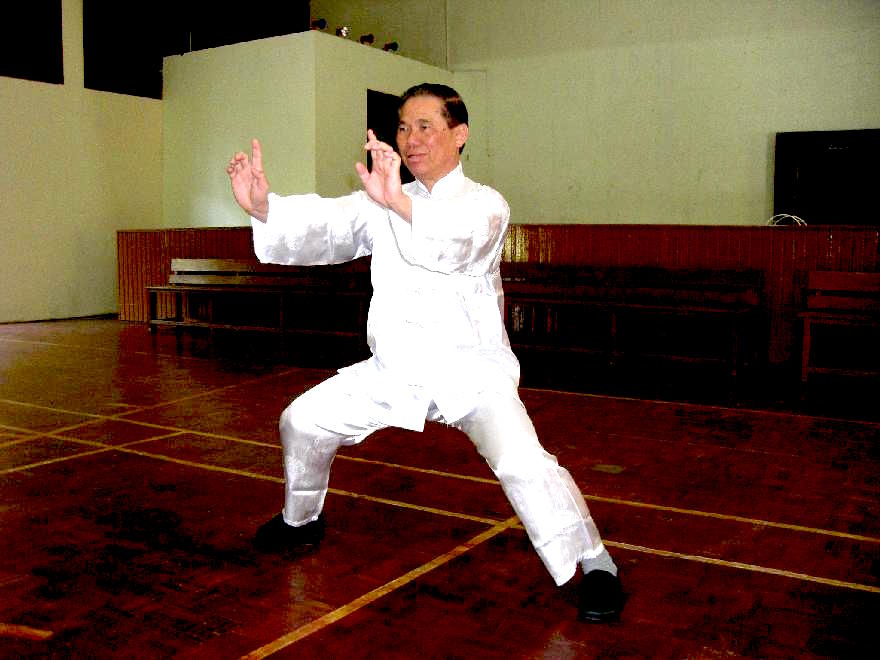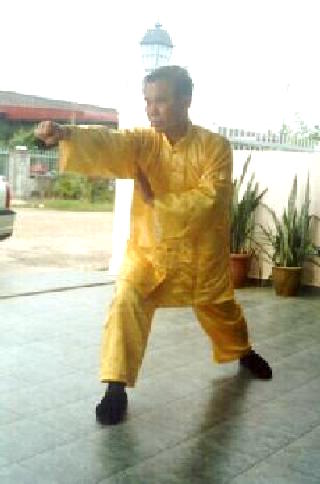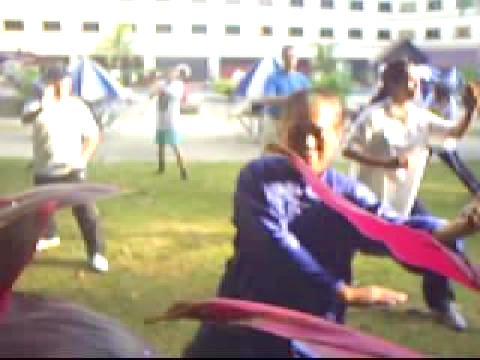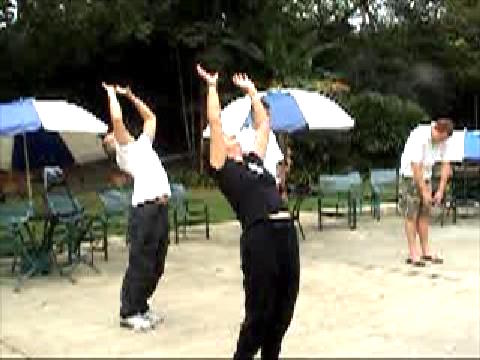June 2009 (Part 3)
SELECTION OF QUESTIONS AND ANSWERS

“Golden Bridge demonstrated by Grandmaster Wong
Question 1
My training has been going well. I have been training every single day morning and night. I stay in Golden Bridge for may be 20 minutes. I understand it is not an endurance exercise so I do my best to keep my whole body as relaxed as possible throughout. I feel stronger and definitely am feeling more chi and internal force all over.
How long should we aim to stay in the Golden Bridge exercise? Is it the longer the better with good form? Should we limit ourselves to a certain amount of time?
— Chris, Australia
Answer
Staying at the Golden Bridge for 20 minutes is very good.
While it is true that the longer one stays at the Golden Bridge the better, in practical terms it may not be necessary. Nowadays when the standard of kungffu is quite low, if one can stay correctly at the Golden Bridge for 5 minutes, he would have sufficient internal force to meet most ordinary fighters. If he can stay for 15 minutes, most martial artists would find him powerful.
Hence, the extra time for Golden Bridge can be utilised for other aspects of kungfu training, like practicing combat sequences.
This reminds me of an incident many years ago from which we can learn a few good lessons. One of my senior disciples loves stance training. He would stay at the Horse-Riding Stance or Golden Bridge literally for an hour, and enjoy it thoroughly. I told him that he should also practice combat application, otherwise his training would be imbalanced. So I taught him the 12 basic Shaolin combat sequences.
He is an old-timer. That was the time before I introduced the 16 basic Shaolin combat sequences which we practice now. These 12 sequences were the ones I taught in Malaysia before I started teaching overseas.
One evening the senior disciple came to see me with another kungfu master who had been teaching kungfu for more than 20 years with emphasis on free sparring.
The master asked whether I could teach him Golden Bell. I said no. First he had to be my student, and then a good student. But even if I wanted to teach him Golden Bell, it could not be done in just one evening. Interestingly, most of our instructors now have Golden Bell, not from any special techniques of Golden Bell that I taught them but from training the way I have asked them to train.
Then they asked whether I could see them sparring and give some comments. This I gladly did.
Although the kungfu master had much experience in free sparring, he had no advantage at all over my disciple who hardly had any free sparring experience. This was simply because of the tremendous internal force of my disciple. If you imagine a five-year old Karate black-belt fighting against a muscular adult with no holds bar, you could have a picture of the situaion. My disciple was not muscular, but in terms of force the kungfu master was like a five-year old against a muscular adult.
But my disciple also had no advantage over the kungfu master, simply because my disciple could not use any combat techniques effectively. I advised him to use any of the combat sequences I had taught him.
My disciple still fought randomly. I was getting impatient. "Just use any of the combat sequences I have taught you," I said.
"Sifu, I have forgotten them," he confessed.
By then the kungfu master was panting heavily. I took this opportunity to ask them have a rest. Meanwhile I took my disciple out of the room and showed him Sequence 11, which is now Sequence 10 in our present 16 basic combat sequences, namely, "White Horse Presents Hoof".
After about 10 minutes, during which time my disciple went over the combat sequence a few times, the free sparring resumed. Without a single exception, each time my disciple applied the combat sequence, he literally forced the opponent to the wall. The kungfu master, despite his many years of free sparring experience, had no chance at all against my disciple's attacks.
The attacks were actually quite straight-forward. My disciple just kept repeating "Black Tiger Steals Heart", "Fierce Tiger Speeds through Valley", "White Horse Presents Hoof", and "White Snake Shoots Venom".
The kungfu master was so frustrated by my disciple's pressing attacks that he left hurriedly. He missed an opportunity to better his combat efficiency; he was not humble enough to learn.
Question 2
Since I'm studying Taiji I do a lot of zhan zhuang qigong. I have Sifu Wong's "Complete Book of Shaolin" to develop Cosmos Palm. Do I just do what it says in the book: "Forceful Windmill", "Pushing Mountain" and "Carrying the Moon and Sun" or are there finer points to the training?.
— Thomas, Australia
Answer
I am glad you are putting some effort in developing force and are getting good results. Developing force is a very important aspect of kungfu training, including Taijiquan. There is a kungfu saying as follows: "lean khuen pat lean kung, thow lou yeit cheong hung" (Cantonese pronunciation), which means that "if you only train techniques but never develop force, your training will be futile even if you train a whole lifetime".
Nevertheless, the kind of force you have chosen, "Cosmos Palm", is advanced. It is advisable that you train under a master.
But it appears that you are progressing well. You can, therefore, carry on, but just be careful that you follow my instructions in my book respectfully.
There are of course finer points, which are not feasible to be explained in words. These finer points need to be learnt personally from a competent teacher.
But in your case I would advise you to be gentle in your internal force training -- gentle in your physical movements, gentle in your breathing and gentle in your mental state.

“"Fierce Tiger Speeds through Valley" is a crucial pattern in Combat Sequence 10 used to press an opponent to a wall
Question 3
I am asking because qigong is quite pleasant, compared to hard conditioning. I'm in no rush to develop enough gong to break a brick. I just want to make sure I don't harm myself in anyway and to develop force quicker
Answer
Not harming yourself in your training is very important. Unfortunately, many people harm themselves, usually not even realizing it. Many martial artists today, for example, are less healthy after many years of training than before they started training. Most of them train in external arts. The harm derived from incorrect training in the internal arts is more serious.
Being gentle in your approach is an excellent way to avoid harming yourself unknowingly. Surprising it may be to some people, it is also an excellent way to ensure the development of internal force.
You must not rush in your internal force training. Rushing, which results in over-training, is a common cause of harmful side-effects. Just enjoy your training and let your internal force develop naturally.
Question 4
Since I started Taiji I haven't had a single illness. I've developed more force than I ever did with other martial arts. My bones seem harder, so it seems like I'm training Iron Shirt and other skills as side effects because all I do is the forms and qigong.
Answer
Congratulations for your good result. Being free from illness is certainly more valuable than being able to break many bricks.
What you are experiencing is the natural progress of Taijiquan internal force development. Taijiquan itself is qigong. This means that by practicing the Taijiquan forms correctly, and without having to attempt other qigong exercises outside of the Taijiquan repertoire, a devoted practitioner can develop internal force, which will contribute to his good health, combat efficiency and spiritual cultivation.
This was what Taijiquan practitioners in the past did. They did not hit sandbags, carry weights, run long distance or practice other qigong exercises outside their Taijiquan repertoire, yet they were very fit and powerful. They could also break bricks and withstand strikes on their body by opponents withhout sustaining injury. Modern Taijiquan practitioners who try to incorporate other qigong exercises or hard conditioning into Taijiquan fail to understand that Taijiquan by itself is a profound and complete set of qigong.

By practicing Taijiquan movements correctly, one can develop internal force
Question 5
I just want to be able to use my qi for more active things like Cosmos Palm and Golden Bell.
Answer
In modern times the types of force developed by Taijiquan masters are normally not called Cosmos Palm and Golden Bell, though the effects may be similar. Then, what are they called? Taijiquan masters do not give special names to these types of force.
If a Taijiquan master can cause internal injuries on his opponents by a seeming gentle tap, or withstand opponents' attacks without himself sustaining any injuries, others would not normally refer to his force as Cosmos Palm or Golden Bell, but only say that he has tremendous "nei kung" or internal force. Cosmos Palm and Golden Bell are generally Shaolin terms.
Why is this so? One main reason is convention. Another main reason is the way of training. Shaolin masters who possess Cosmos Palm or Golden Bell have more specific methods to develop these types of internal force, whereas Taijiquan masters achieve similar types of force through their regular Taijiquan training.
Nevertheless, I beleive the greatest of Taijiquan masters like Zhang San Feng and Wang Zhong Yue would exhibit force which their contemporaries would call Cosmos Palm and Golden Bell. But then at that time people did not refer to the art that Zhang San Feng and Wang Zhong Yue practiced as Taijiquan; they called it Shaolin Kungfu!
Question 6
By doing the form I'm sending qi throughout my body, so would this be like doing a Microcosmic Orbit and Self Manifested movements?
Answer
No, technically it is not so. When a Taijiquan master performs "Grasping Sparrow's Tail", for example, his qi flows from his dan tian to his arms. When a qigong master performs the Microcosmic Orbit or Self-Manifested Chi Movement, his qi flows along his conceptual and governing meridians or all over his body randomly.
However, if the Taijiquan master learned the Microcosmic Orbit or Self-Manifested Movement before (using their respective methods), when he performs "Grasping Sparrow's Tail" as his qi is flowing from his dan tian to his arms, simultaneously his qi may also be flowing along the conceptual and governing meridians. And after performing "Grasping Sparrow's Tail" if he lets go, he may go into Self Manifested Movement. In other words, he does not need the original methods he learnt earlier to generate his Microcosmic Orbit or Self Manifested Movement, he can use "Grasping Sparrow's Tail" or any Taijiquan patterns.

Course participants at an Intensive Chi Kung Course perform "Carrying the Moon" as chi kung. Many people, however, perform the same movement as gentle physical exercise.
Question 7
I am beginning the cultivation of chi through the practice of chi kung and 108-Pattern Taijiquan Set. From the perspective of a master of Kungfu, would you say that the "Eight Pieces of Brocade" would be effective for energy cultivation?
— Thomas, USA
Answer
Yes, the Eight Pieces of Brocade are very effective for energy cultivation -- if you practice them as chi kung and not as physical exercise. The crucial difference is that chi kung works on energy, whereas physical exercise works on the physical body, like joints and muscles. If you do not know what working on energy is, then you are practicing it as physical exercise. If you practice it as chi kung, you will know what working on energy is, just like if you swim or eat an orange, you will know what swimming or eating an orange is.
Practicing physical exercise also gives you good benefits, like loosening your joints and muscles, generating better blood flow, and making you relaxed and balanced. But these benefits are incomparable with those of practicing chi kung, like overcoming pain and illness, enjoying good health, vitality and longevity, and expanding mind and spirit. If you practice physical exercise, no matter for how long you may practice, you will never have these wonderful benefits.
The 108-Pattern Taijiquan Set is chi kung too. But nowadays, like the Eight Pieces of Brocade, it is usually practiced as physical exercise.
It is significant to note that the form of the exercise is the same; it is how the exercise is performed that differentiates it between chi kung or physical exercise. In other words, a person may perform the 108-Pattern Set or the Eight Pieces of Brocade as chi kung, and another person may perform the same 108-Pattern Set or the Eight Pieces of Brocade as physcial exercise. Like most people, you probably practice them as physical exercise. If you had practice them as chi kung, you would not have asked the question; you would have obtain the answer from your direct experience.
If you are really keen to practice genuine chi kung and enjoy these wonderful benefits, I would recommend that you learn from one of our certified instructors. Understandably, some people would accuse me of advertising my school, but honestly I want to save your time. In the past, I used to advise sincere seekers to learn from competent chi kung teachers. But experience has shown that either they wasted a lot of time searching or they ended up with learning physical exercise.
Question 8
Does this form require the foundation of a hundred days? I have heard that this is also used in Shaolin martial arts training.
Answer
Whether practicing the 108-Pattern Taijiqjan Set, the Eight Pieces of Brocade or any other form of chi kung exercises requires a practitioner to abstain from sex for a hundred days, depends on a few factors, like his needs and aspirations, and how he practices the exercise.
If he practices them as physical exercise, there is no need to abstain from sex for a hundred days.
In the past, those who practiced the exercises as chi kung chose to abstain from sex for a hundred days so as to build a strong chi foundation. But conditions are different today, and the standard demanded of practitioners is not as high as that in the past. Hence, it is not necessary to abstain from sex for a hundred days.
However, if a person practices chi kung to overcome a serious illness, it is advisable for him to abstain from sex until he has recovered. Enjoying sex expends quite a lot of energy. For a sick person, it is wiser to conserve the energy for his recovery.
LINKS
Selected Reading
- The Shaolin Wahnam International Show
- How are these Odd Patterns used in Combat?
- Miraculous Experiences of Distant Chi Transmission
- Shaolin Seventy Two Chin-Na Techniques
- A Precious Gift which Brings Joy in Many Ways Every Day
